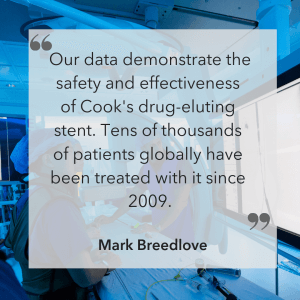Findings contradict meta-analysis linking paclitaxel-coated devices and increased mortality
 Bloomington, Ind. – Today at the Leipzig Interventional Course (LINC), Cook Medical participated in significant discussion about the use of paclitaxel to treat patients suffering from PAD. Through several presentations to meeting attendees, data supported the use of paclitaxel-coated devices to help the more than 200 million1 patients globally who are fighting the disease.
Bloomington, Ind. – Today at the Leipzig Interventional Course (LINC), Cook Medical participated in significant discussion about the use of paclitaxel to treat patients suffering from PAD. Through several presentations to meeting attendees, data supported the use of paclitaxel-coated devices to help the more than 200 million1 patients globally who are fighting the disease.
“We believe industry-wide discussion on topics related to patient safety and long-term patient outcomes are critically important. In the case of paclitaxel, we have studied this drug for more than 20 years and tens of thousands of patients have been treated with Zilver PTX,” said Mark Breedlove, vice president of Cook Medical’s Vascular division. “The recently published meta-analysis linking paclitaxel-coated devices and increased mortality didn’t include patient-level data.”2
Cook data demonstrate the safety and effectiveness of the Zilver PTX Drug Eluting Stent. This includes 479 patients in a 5-year follow-up randomized controlled trial3. A recently released Japanese five-year post-market study4 on Zilver PTX showed positive long-term safety and effectiveness outcomes in challenging real-world patients.
Professor Michael Dake, the principal investigator for the Zilver PTX Randomized Controlled Trial, presented at LINC on “Long-term safety information on Paclitaxel eluting stents – Insights from the Zilver PTX programme.” After reviewing all patient level data in the Zilver PTX five-year follow-up, Dake stated that “Cook’s patient level data demonstrate no increased mortality rates at five years with use of a Zilver PTX paclitaxel-coated stent versus the use of non-coated stents and balloons.”
View the full scientific exchange, including Dr. Dake’s presentation, here.
Zilver PTX is indicated for improving luminal diameter for the treatment of de novo or restenotic symptomatic lesions in native vascular disease of the above-the-knee femoropopliteal arteries having reference vessel diameter from 4 mm to 7 mm and total lesion lengths up to 300 mm per patient.5
Caution: U.S. federal law restricts this device to sale by or on the order of a physician (or properly licensed practitioner). Use of this drug-eluting peripheral stent carries the risks associated with peripheral artery stenting, including vascular complications and/or bleeding events. Refer to the Instructions for Use (IFU) for full prescribing information including information on potential adverse events, contraindications, warnings, precautions, and summary of clinical data.
Dr. Michael Dake is a paid consultant for Cook Medical.
Find other recent news on Zilver PTX.
1 Shu J, Santulli G. Update on peripheral artery disease: Epidemiology and evidence-based facts. Atherosclerosis. 2018 Aug; 275: 379–381.
2 Katsanos K, Spiliopoulos S, Kitrou P, et al. Risk of death following application of paclitaxel‐coated balloons and stents in the femoropopliteal artery of the leg: A systematic review and meta‐analysis of randomized controlled trials. Journal of the American Heart Association. 2018;7:e011245
3 Dake MD, Ansel GM, Jaff MR, et al. Durable clinical effectiveness with paclitaxel-eluting stents in the femoropopliteal artery: 5-year results of the Zilver PTX randomized trial. Circulation. 2016;133(15):1472-1483.
4 Five-year evaluation of Zilver PTX stent in a real-world population continues to show favourable outcomes. Vascular News Web site. https://vascularnews.com/five-year-evaluation-zilver-ptx-stent/. Accessed January 20, 2019.
5 Refer to Instructions for Use (U.S. IFU) for clinical data overview (IFU0118).
About Cook Medical
Since 1963, Cook Medical has worked closely with physicians to develop technologies that eliminate the need for open surgery. Today, we are combining medical devices, biologic materials and cellular therapies to help the world’s healthcare systems deliver better outcomes more efficiently. We have always remained family owned so that we have the freedom to focus on what we care about: patients, our employees, and our communities. Find out more at cookmedical.com, and for the latest news, follow us on Twitter, Facebook, and LinkedIn.